|

The George Washington University Law School has undertaken an ambitious plan—to create a space for learning that is equal to the quality of scholarship and instruction being carried out therein. Building the future at GW Law began in 2000 and is planned in four phases. Phases I and II have been completed. Phases III and IV commence in 2003 and promise to bring a new shape to the Law School campus.
Justice Scalia Joins GW Law in Dedicating New Addition
|
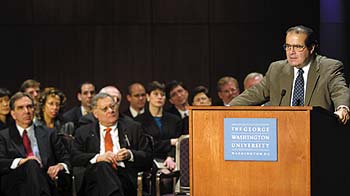
Justice Scalia delivered the building dedicaion address in GW's Jack Morton Auditorium.
|
In the tradition of opening new buildings at the Law School, a U.S. Supreme Court Justice joined the festivities in March when the Law School celebrated the completion of Phase II of the program and the opening of its newest building at 700 20th Street, next to the Jacob Burns Law Library. Justice Antonin Scalia marked the special occasion by helping to cut the ceremonial ribbon to officially open the building and by providing insightful remarks in the formal dedication ceremony.
The weather March 8—sunnier and warmer than usual for the time of year in Washington—was auspicious. It was fitting that such a day mark the opening of the newest addition to the Law School.
In the morning, Law School administrators, faculty members, alumni, and friends gathered in the first floor reception area of the Law School’s new 700 20th Street facility to await the arrival of U.S. Supreme Court Justice Antonin Scalia. Once there, Scalia mingled with the group for the pre-dedication reception.
|
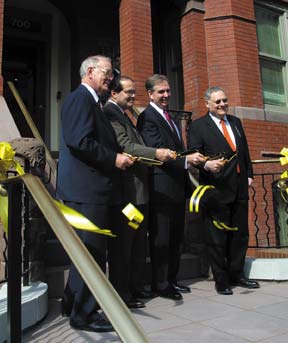
GW Chairman of the Board of Trustees Charles T. Manatt, JD ’62, Justice Antonin Scalia, Dean Michael K. Young, and GW President Stephen Joel Trachtenberg cut the ceremonial ribbon to open the new building.
|
Shortly thereafter, a ceremonial ribbon cutting by Justice Scalia, Dean Michael K. Young, GW President Stephen Joel Trachtenberg, and GW Chairman of the Board of Trustees Charles T. Manatt took place on the steps of the new building.
Those assembled then moved to GW’s new Jack Morton Auditorium to hear remarks from Young and Justice Scalia. Dean Young quoted Sir Winston Churchill: “‘Every day you may make progress. Every step may be fruitful. Yet there will stretch out before you an ever-lengthening, ever-ascending, ever-improving path. You know you will never get to the end of the journey. But this, so far from being discouraging, only adds to the joy and glory of the climb.’”
“That is how I look at today’s wonderful addition to our Law School,” Young said. “This Law School is on a journey of never-ending improvement. Each step in that journey is based on the work and effort of the past, and the buildings of the Law School are a physical view of the intellectual achievement that is produced here. Thus, this addition is so much more than mere bricks and mortar or square feet per student. It is growth, it is progress, it is betterment, but, most importantly, it is a physical representation of what we strive to represent intellectually: ‘the joy and glory of the climb.’”
In his remarks, Justice Scalia commented on GW Law’s long history in Washington, D.C. “This place of course has a prominent role in the law nationally, but especially a prominent role in the life of this city,” he said.
Scalia also had some advice for the faculty, students, and friends of the Law School.
For the faculty, he recalled how he begrudgingly taught class, when he preferred to be researching or writing a law review article. In retrospect, he regrets it, he said. A law review article may have a shelf life of 10 years, but sharing education and a passion for the law with students is timeless, he said. “The reality is that the part of your academic career that will have the most lasting impact, and that will be remembered after you are gone, is those hours that you spend producing a living intellectual legacy in the classroom.”
For the students, he encouraged them to take advantage of their learning opportunities in school. The work environment is far different from when he graduated from law school, he said. At that time, firms would provide years of training for newly hired attorneys.
“For various reasons, law firms do not, cannot undertake the extensive training that they used to … The notion that you can go to a law firm with the expectation of staying there forever—that just doesn’t exist anymore. So any law firm that trains you is probably training you for somebody else—not a very intelligent enterprise. So I advise you students to make the best use of your time here and not to give short shrift to that aspect of legal education that the law schools do best: that of a systematic body of knowledge concerning discrete areas of the law.
Finally, he addressed the friends and supporters of the law school. The gradual estrangement of the academy from the practice is a trend that bothers him, he notes. The job of keeping the academy close to the bar, he said, must fall largely on the bar itself.
Following the dedication speeches, further celebration continued at a luncheon reception in the Marvin Center, where Justice Scalia visited with guests as well as students, who came with books in hand. Scalia took the time to speak with the students and honored many of their requests for book inscriptions.
The afternoon concluded with a visit by Scalia to the Faculty Conference Center, where he and the faculty continued their discussions about the law.
The daylong celebration ended with a black-tie gala at the U.S. Senate Caucus Room, where the Law School honored former Senior Associate Dean John. S. Jenkins, JD ’61, with the Jacob Burns Award for Extraordinary Service to the Law School, and Sen. Harry Reid (D.-Nev.), JD ’64, received the William Fulbright Public Service Award. (For more information on the evening reception, see the Alumni section,).
Preserving Memories
During the building dedication ceremony, several people contributed items to a “time capsule,” a small box that will be inserted and preserved in the new building’s cornerstone. This time capsule will remind people—many years hence—of the current life and times of the Law School community. Included items, listed below, represent the alumni, University and Law School leadership, as well as the faculty, students, and staff:
- A scroll of the honored alumni donors to the new building
(placed by Charles T. Manatt, JD ’62, chairman of the GW Board of Trustees)
- A signed copy of University President Stephen Joel Trachtenberg’s book, Thinking Out Loud
(placed by President Trachtenberg)
- A piece of the roof of the original building with a plaque that reads “700 20th Street, N.W., piece of original roofing 1892” and the engraved ceremonial scissors used to cut the ribbon on the entrance of the new building
(placed by Dean Michael K. Young)
- A picture of the faculty taken at a recent faculty retreat
(placed by Professors Peter Raven-Hansen and Todd Peterson, chairmen of the building construction committee)
- A book signed by the current student body with their thoughts, memories, and reflections of the school
(Placed by: Philip Tahtakran, outgoing SBA president; Emily Hargrove, outgoing SBA vice president, Olamide Famuyiwa incoming SBA president; and Joshua Harris, incoming SBA vice president.)
- The 2001-02 Law School Bulletin, a copy of the fall 2001 picture book of students and faculty members, a picture of the staff from a recent staff retreat, and the salary scale for Law School employees
(Placed by Roseanne O’Hara, director of student services, and Beverly Calvert, supervisor of the faculty secretaries)
|
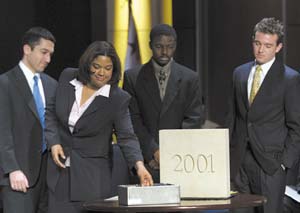
Outgoing SBA President Philip Tahtakran and Vice President Emily Hargrove, and incoming SBA President Olamide Famuyiwa and Vice President Joshua Harris place a book of memories created by the Law School student body in the time capsule.
Photo by Abdul El-Tayef/WPPI
|
In addition, special letters of recognition received from President George W. Bush and from Speaker of the House of Representatives J. Dennis Hastert (R.-Ill.) were included.
Of GW, President Bush wrote, “George Washington University’s pursuit of academic excellence in medicine, law, and the arts has played a significant role in educating America’s leaders. This building has contributed to the Law School’s rich history of educating students and examining law.”
Similarly, Hastert wrote, “George Washington University’s law school already has a stellar reputation, and the new cornerstone addition will give prospective students even more reason to consider preparing for the legal profession at GW Law.”
A copy of Justice Scalia’s remarks from the building dedication rounds out the list. With these contents of the cornerstone time capsule, the Law School’s past, present, and future are officially joined in the new building.
Building for the Future
Building for the future at GW Law began in 2000 and is planned in four phases. Phases I and II have been completed. Phases III and IV commence in 2003 and promise to bring a new shape to the Law School campus.
Phase I:
Reinventing the Learning Environment
|
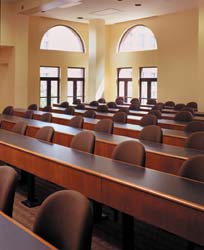
Each new desk space provides power outlets for student laptops.
|
Phase I of the renovation and expansion was completed in summer 2001 with the transformation of classrooms into places where ideas are exchanged in comfort, and where technology will let GW Law’s faculty and students take advantage of virtually any learning experience in the coming decades.
The extensive refurbishment focused mainly on transforming existing classroom space by providing state-of-the-art technology, improved classroom ergonomics, and greater uniformity within the building’s internal structure. Construction began immediately after the last final exam of the spring 2001 semester and was completed in time to greet the new class arriving for fall 2001 orientation.
Twelve classrooms totaling more than 18,000 square feet were transformed with new furniture, paint, carpeting, and electronic hardware. In addition to creating a more visually pleasing environment, the renovation gave GW Law students more comfortable seating, increased per-student desk space, and power outlets for laptops at each student station.
The renovation also provides vastly increased instructional support. The front of each classroom was hardwired with the latest ‘smart podium,’ providing direct Internet access, video conferencing, and telecommunications. Each smart podium has a built-in PC, keyboard, and mouse, along with a CD/DVD drive and access to the Law School network. A VCR also is part of the package. Faculty members may also plug their own laptop computer into the podium.
Professors control the smart podium through a touch-panel control pad with a 15-inch liquid crystal display. In addition, all of the Lerner Hall classrooms have ceiling-mounted LCDs. Cameras and microphones were installed, allowing faculty members to teach online in streaming video or record classes for later viewing. Microphones placed throughout the larger Lerner classrooms allow for better audio when students are asking and answering questions.
Phase I also increased maneuverability within the Law School’s buildings thanks to widened hallways, creating a more uniform flow within the buildings to make them more “user friendly,” says Associate Dean for Administrative Affairs Tom Morrison, who served as the main Law School contact for construction activities.
Phase II:
Turning the Corner at 700 20th Street
In December 2001, the Law School completed Phase II with the renovation and occupancy of 700 20th Street, a historic townhouse in the heart of the Foggy Bottom neighborhood.
This project allowed the Law School to group a number of administrative offices in closer proximity (e.g., student affairs, admissions, financial aid, international programs, career development), making services more accessible to students and creating greater functional efficiency. At the same time, a number of student groups were relocated back into the Law School complex, a trend that will continue with future expansion projects.
As part of Phase II, the Law School also constructed a Faculty Conference Center that provides a physical facility commensurate with the quality of the programs and speakers GW Law hosts on a regular basis.
|
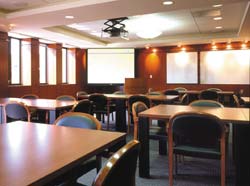
Presentation support includes a projector/camera flush-mounted in the ceiling; a drop-down screen; a white board integrated into the paneled wall; and a smart podium with built-in PC.
|
Once known as the “President’s House,” the historic townhouse at 700 20th Street now serves as the anchor for the Law School complex. The renovated and expanded building houses the dean’s suite, JD admissions, financial aid, international programs, student affairs, faculty offices, reception areas, and five conference and seminar rooms.
The building is a signature space that complements the aesthetic appeal of the neighborhood. The architect George S. Cooper designed the original dwelling for John W. Foster in 1892 in a style representative of late 19th-century Washington row house construction. As a University property, it had been known as the “President’s House,” the “Old President’s Offices,” and most recently as “Building E.” The building had provided administrative offices for a variety of University departments and was occupied by the Law School for several years prior to its renovation.
The architects maintained the historic facade of the 1890s townhouse while creating a connection between the Jacob Burns Law Library and Stuart Hall. The Law School will acquire Stuart Hall in 2002-03, “turning the corner” onto the G Street side of the University Yard.
The ground floor of 700 20th Street houses the admissions and financial aid offices, which were relocated to this prime location for student access from temporary facilities several blocks away.
The first floor serves as the principal reception area for the building and is the new home for the Student Affairs Office. Also on the first floor are the international programs offices, a seminar classroom, and the graciously appointed Dean’s Reception Room, complete with a historic fireplace and bay window overlooking G Street.
The William P. Barr Dean’s Suite also welcomes students and visitors into 700 20th Street. In addition to a reception area, the dean’s office, and the associate deans’ offices, the second floor has one of the building’s three conference rooms.
The third and fourth floors hold two conference/seminar rooms for hosting advanced classes, meetings, and events, as well as 14 faculty offices.
The faculty lounge on the fifth floor of the Burns Law Library was expanded into the new addition, creating the Faculty Conference Center.
Phase III:
The Law School Complex Comes Together
In 2003, Phase III will cap off the momentum created by the renovation of 700 20th Street as the Law School restyles and occupies the adjacent building, Stuart Hall, and major portions of Lisner Hall (which adjoins Stuart) on the G Street side of the University Yard. With the completion of Phase III, the Law School complex will form a continuous “L” of integrated buildings along two sides of the University Yard.
The addition of Stuart and Lisner Halls will expand dramatically the space available for students, faculty, and programs. Included in this space are nine classrooms and more than 40 offices.
The implications of this phase for the intellectual life of the Law School are significant. The adjoined buildings will form a cohesive unit for the Law School to provide ample programmatic, study, office, and lounge space to support a thriving intellectual community. The goal in Phase III is to create an environment that is sufficiently spacious and appealing to encourage students to engage in that most critical law school dynamic—learning from each other outside the classroom.
More offices will allow the Law School to accommodate an expanding faculty as well as provide space to host more visiting scholars—from academia, and also from practice, the judiciary, and political office—increasing the intellectual energy of the school and taking fuller advantage of the Law School’s unparalleled location in the nation’s capital.
Physical expansion also will allow for programmatic expansion, both through increased academic offerings as well as additional research centers and institutes to study the issues that most concern our society.
Phase IV:
Building the Future
|
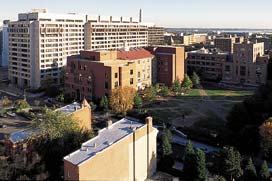
The Law School complex, comprising the left side of the University Yard, will turn the corner and include Stuart and Lisner Halls to form an "L" around the University Yard.
|
Slated for completion later this decade, Phase IV is of tremendous importance to GW Law: a new Learning Center befitting a teaching and research community of international stature. Under one roof, the new Learning Center will house GW Law’s expanding library collection, the offices of GW Law’s student journals, several new large classrooms, and vastly expanded student study space.
Building History
The George Washington University Law School is the oldest law school in the District of Columbia. It originally was established in 1826. However, classes were discontinued just one year later due to insufficient enrollment and lack of financial support.
|
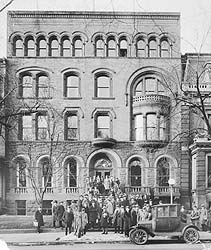
A temporary home for the Law School from 1921 to 1925 was this McPherson Square building at 1435 K Street, a former headquarters for the Department of Justice.
|
The Law School was re-established in 1865, when Columbian College began holding classes in the former Trinity Episcopal Church building on 5th Street between D and E Streets.
The Department of Law offered the degree of bachelor of laws, which required two years of study. Sixty graduates, from 22 of the then 37 states, received degrees in 1867. The Law School continued to have a student body and a faculty that reflected its location at the heart of the seat of the nation’s government. Supreme Court Justices David J. Brewer and John Marshall Harlan were among the many prominent members of the bench and bar who were on the Law School faculty.
In 1872, the trustees adopted a resolution to establish a one-year postgraduate course in legal practice. That same year, Lydia S. Hall and Belva Ann Lockwood graduated from the National University Law School and became the school’s first female graduates. (National University Law School, which had held an important place in legal education in the District since 1869, was merged into GW Law School in 1954.) In 1877, one year after the first such program was adopted in the United States, the Law School instituted a course leading to the degree of master of laws.
The Old Trinity Church building was occupied by the Law School until 1884, when law classes were moved to the Columbian University building at 15th and H Streets. In 1898, a new Law School building was constructed adjacent to the Columbian University building.
The Intellectual Property and Patent Law Program was initiated in 1891, with the first course in patent law taught by the commissioner of patents. The George Washington Law Alumni Association was established in 1912, and in 1914 the Department of Law became the Law School. (In 1904, Columbian University became The George Washington University by an Act of Congress.)
A temporary home for the Law School became the old Justice Department building at 1435 K Street in MacPherson Square from 1921 to 1925.
|
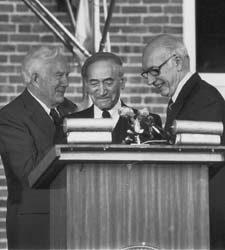
Warren Burger, Supreme Court chief justice in 1984, Jacob Burns, and University President Lloyd Elliott delivered remarks during the dedication of the expanded Jacob Burns Law Library. Several hundred people turned out to pay tribute to Burns and to hear an address by Burger on a topic of particular interest to those involved in the law: prison reform.
|
In 1924, a new Law School building was constructed on 20th Street between G and H Streets. Stockton Hall was dedicated in November 1925 and named for Rear Admiral Charles Herbert Stockton, University President, 1910-18. The design of Stockton Hall was intended to complement Corcoran Hall, which it faces across the University Yard.
The Law School was made a graduate school in 1936 and the degree of juris doctor was established. A baccalaureate degree was a prerequisite for admission to the JD degree program.
As its contribution to the war effort, GW maintained the third floor of Stockton Hall during 1941 for use by the U.S. Army Quartermaster Corps in testing fabrics for tropical use.
The Law School began accepting foreign attorneys into specially designed programs in 1946, and in 1948, Law School enrollment surpassed the 1,000 mark.
In 1965 the International and Comparative Law Program was established. Two years later, an important addition to the Law School’s facilities came with the completion of the Jacob Burns Law Library, which adjoined Stockton Hall to the south and contained faculty offices as well as library stacks and study areas. The building was funded in part by the generous support of Jacob Burns, LLB ’24, LLD ’70.
|
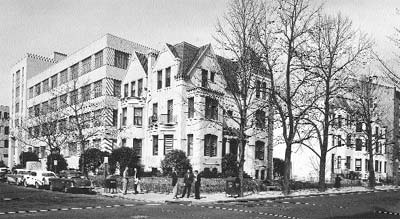
The corner of 20th and G Streets, 1950s, before construction of the Law Library and the renovation of the President's house, 700 20th Street.
|
The Law School’s Enrichment Program, which has brought such illustrious speakers as Supreme Court Justices Scalia, O’Connor, Kennedy, and Ginsburg; Senators Fred Thompson, George Mitchell, and Orrin Hatch; author Scott Turow; columnist George Will; FCC chairman Reed Hunt; ACLU president Nadine Strossen, and many others to the school, was established in 1981.
In 1984, Lerner Hall was completed on the corner of 20th and H Streets, adjoining Stockton Hall to the north. Named for University Trustee Theodore N. Lerner and his wife Annette, Lerner Hall was constructed on the site previously occupied by Bacon Hall. As part of this major construction and renovation project, the “Burns South” addition was made to the library, increasing its overall square footage and giving the building its current profile, and Stockton Hall was significantly renovated. Lerner Hall and the expanded Burns Law Library were officially dedicated in a ceremony presided over by Supreme Court Chief Justice Warren Burger.
In 2001, as this issue of the magazine celebrates, significant interior renovations were made throughout the Lerner, Stockton, and Burns buildings, increasing the aesthetic appeal, ergonomics, instructional capabilities, and student space of the Law School complex.
|
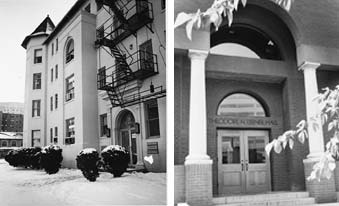
Bacon Hall stood on the corner of 20th and H Streets next to Stockton Hall. Lerner Hall (right replaced Bacon in 1984).
|
Back to top | April 2002 Table of Contents
|